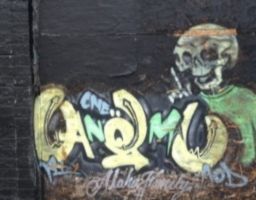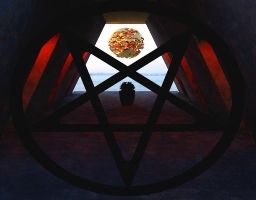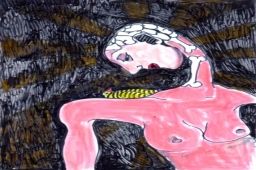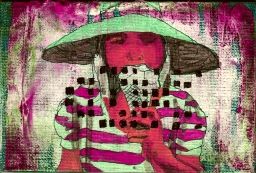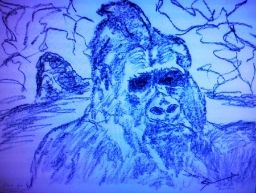
Friday, October 31, 2025
0c☨☉b☄☈ D☈eaM

Empty Bottles
by John Shirley

They should have been expecting me.
They’d received a letter, posted a month earlier. It contained a note from Mom and a short letter from me. Mom’s note referenced a meeting she’d had when they’d signed the new agreement about my college fund: “You said he could come and visit you any time, Karl, long as I informed you a few weeks ahead, and I’m doing so. You don’t answer phone calls, you neglected to give me your email and I use a landline, so I don’t text. Yes, there are still people with landlines. I hope you remember that invitation. You were looking at your phone when we were talking and I couldn’t tell if we were on the same page or not.”
I almost didn’t go to Dad’s house. I was only in San Jose for a few days, to do some post graduate research, and I thought I should see him, but he hadn’t written back to Mom or called. I wasn’t sure I’d be welcome. But since having the dream—an acutely bad dream--I was troubled by the feeling that I really ought to go see him. At least once. Yes, he had pretty much abandoned me, when I was a little kid. But—why not get some closure?
On a summer day just before sunset, with the crickets starting to stridulate, I got out of the taxi next to the mailbox, suitcase in hand. The taxi drove away before I could tell the guy to wait. Because I was suddenly not sure that my dad still lived here. The house had peeling white paint and the hasty look of houses built way back in the 1960s. The lawn had become knee-high weeds. There was a Tesla parked in the driveway but it was missing a wheel and grass grew up around its axles.
The house’s window blinds were all closed. This was the address, all right, Dad had moved here after the divorce from my mother about sixteen years earlier—but was he still here? I glanced at the open mailbox—saw it was overflowing. Several pieces were moldering on the sidewalk. Mostly junk mail. I noticed a rain-browned envelope sticking out from the rest in the mailbox. It showed my mother’s return address.
“Christ!” I took the letter out, and looked it over. Addressed to my dad. The date confirmed it was definitely the letter. It’d been in the mailbox about six weeks.
I looked at the house again. It seemed very, very still. But the sun chose that moment to dip behind the horizon, and the evening darkened all at once, so I could see light glowing around the edges of the blinds.
Carrying the envelope I went to the door, put down my bag, and knocked. I waited. No response. I looked for a doorbell. Where the doorbell should be, not quite fitting in the gap, was a thimble sized receded disk of glass. One of those front door security cameras. There was a tiny little speaker under the lens.
I waved at the camera. “Hi! It’s Cedric! Your son, Dad! Anyone home?”
I waited. No response.
“We sent a letter a long time ago! Look!” I held it in front of the camera. “More than a month ago!”
I waited a full minute, then knocked again, harder.
The door clicked, and I figured it was unlocked now. I picked up my bag, opened the door and called, “Dad?”
I stepped through into an empty dining room, musty, and smelling of decaying old food. A Roomba was bumbling around the old amber-yellow carpet. Beyond a food prep counter was a small kitchen, with dirty dishes piled in the sink, cabinets with their doors wide open, an avocado green refrigerator, and a clean tile floor.
“Dad?” I called again. I could hear electronics humming. The carpet ran through a doorway into a living room, cluttered with entertainment systems and devices I didn’t recognize. I walked in, saw my eleven-year-old half-brother sprawled on the sofa. I’d never met him, but I’d found a couple of his selfies online.
He’d been plump in the photos; now he was bloated. He was wearing his underpants, and t-shirt that was much too small for his pink belly. His hair was matted and thick with grease.
“Leroy?” I said.
He didn’t look up at me. His focus was on a screen of some kind, propped on his raised knees. I could see the Bluetooth pods in his ears making it hard for him to hear me. He had a phone in his left hand and every so often he thumbed it. It looked like a game, something of the Candy Crush variety.
I dropped my bag on the floor, tapped him on the shoulder--and he startled. “Whuh!”
I raised my voice. “Leroy, it’s me, Cedric. Your half-brother. Dad said I could visit.” I waved the letter at him. “We sent him a letter but it’s been stuck in your mailbox for over a month…”
“Whuh?”
I smiled at him. “Do pardon me…” I reached down and took a Bluetooth pod out of one of his ears.”
“Hey!”
“I’m Cedric, dude.”
“Whuh?” He absently touched the screen in front of him.
“You already said that, bro. Here I am, your half-brother. It’s a fait accompli—I just showed up. You don’t remember hearing about a Cedric in your family? As in, we’ve got half our DNA in common?”
He squinched his already squinched up eyes even more. “Yuh…”
I bent over and looked at the screen on his lap—it appeared to be a transparent pane of glass in a gray plastic frame, and nothing more—except images that came and went when he touched it. “How do you talk to that thing? I don’t see a keyboard.”
“Voice,” he said.
The image currently on the screen was of an athletic looking young dude of about twelve, very handsome, his eyes glittering with intelligence. “Who’s that?”
“’s me,” Leroy said, frowning.
“Oh, like an avatar?”
“’s me.”
“Whatever you say, little brother.” I set his Bluetooth pod on his chest and went to find Dad.
I walked down a short hallway. And something darted in front of me. It looked like a shrunken, translucent, hollow-eyed version of my half-brother—glimpsed as it slid into a crack in the wall. It was as if the crack vacuumed the thing in. And it was gone.
“Leroy!” I blurted, stopping in my tracks.
I shook my head. Either it was my imagination going loopy or it was some kind of projected electronic image. Maybe the kid was pranking me somehow.
I walked on, feeling…odd. Faintly nauseated. Like there was a high-pitched sound bothering my ears but it was so high-pitched it was inaudible—just beyond the range of hearing. Yet I could feel it vibrating against my ear drums.
To the right was a bedroom or a den, I couldn’t tell which because it was jammed with a jumble of mismatched items; electronics, some plugged in on little metal tables, some in wobbly, dust-coated stacks in the corner. There was a sofa, covered with other gear, and tilted back in a Lay Z Boy easy chair was my dad, looking like a larger version of Leroy, but with a beard. He was shaped like a bowling pin, with his narrow shoulders and bulbous middle—a bowling pin wearing a sweat stained bathrobe. His eyes were trapped in pouchy swollen skin around the sockets.
Dad’s hands were busy, one on tapping at the transparent screen held on his lap by a mechanical arm extending from the wall, the other on the keyboard under another screen set up on little metal table beside the chair. A strong smell of sweat and piss came off him. He was flicking his eyes between me and the screens, his lips moving. There was a cooler beside him filled with generic packages of food, and crumpled wrappers. I stepped into the room, stepping over old interlinked PCs, a linked system all in one room, and caught his reluctant gaze.
“Dad—” I waved the envelope at him. “This letter from me and my mom, confirming your invitation and my plan to come today? It’s been turning yellow in your mailbox for a month. You want to read it?”
Dad muttered something. Glanced at me, looked back at the screens, kept tapping and typing as he said. “Not a good time. Should’ve checked. I’ve almost got this done.”
“Almost got what done, dad?”
“A new kind of WiFi. Revolutionary. Can’t talk about it.”
That wasn’t implausible. He had a successful WiFi boosting start-up, some years back. Lost control to investors but retained a decent income from some tech spin-off. “So this is not a good time--when do you want me to come back?”
“Another week, maybe two. Maybe a month.”
I noticed pill bottles on his metal table. One of them was Adderall. Nettled at his dismissal of me, after I’d made the trek here, I said, “Hitting the stealth meth, dad?” I pointed at the Adderall bottle.
“Not meth.”
“It’s the gradual kind of meth but it’ll get you. I don’t know why I’m talking to you like I’m the adult here.”
He didn’t respond to that. Kept tapping and typing, his mouth loose and very red in his gray-black beard.
I went on, “Hey—you want me to leave, fine, but I don’t have
anyplace else to stay in this town tonight and I’m on a tight
budget. Okay if I just stay here tonight? Leave in the morning. Maybe
you’ll get a chance to unhook in the morning we’ll have a
chinwag, as Mom likes to say. Does anyone say chinwag in this country
besides Mom? Anyhow…”
“The garage.” Tap tap, type type.
“What about it?”
“Stay in there. Electric heater, a cot. Some packaged food. Spare PC you can hook up. Games.”
“You know how mom is, she’s kinda Luddite. Or machine minimalist or whatever. So I never got into it. I do have a cell phone here, and I have a laptop at home but that’s it.”
Tap. Type. Tap. Type.
“Uh—how about upstairs? Looks like there’s an attic room.”
“Filled with servers.”
“Servers? Like rows of big computers? Really! The garage it is.” I shrugged, tossed the water-stained envelope onto the corner of the little metal table and turned away, deciding I’d should see if Leroy’s mother was here. Best say hello so she didn’t think I was a home invader.
Marjorie was farther down the hall, in a bedroom, panting in puce yoga tights as she pumped away on an exercise bicycle, tilting on its platform, and turning its handlebars to veer virtually through the digital canyons she was seeing in her VR goggles. She was in early middle age, in good shape, her shoulder length hair striped pink and neon blue. Her muscular limbs were bronzed from the tanning lamp I could see over the bed in a corner. A vibrant contrast to her housemates.
She couldn’t see I was here so I called out, “Marjorie! It’s Cedric!”
She yipped in startlement, and clawed her VR glasses off.
“Um…” She stared at me, mouth open. “Who?”
“Cedric—Leroy’s half-brother. We’ve never actually met but I’m sure my father complained about having to contribute to my tuition--”
“Oh, god he used to spew the venom over that, alright, ha!” She climbed off the bike, dabbed her forehead with a small towel, and looked me over in the most candid way anyone’s ever done it. She cocked her head toward a juicer on a table beside her bike. “Want some smoothie? Energy greens.”
“Naw, I’m good.”
She reached out and patted my upper arm, in a way that told me she was checking for muscles. “Look at you! You almost look healthy!”
“Uh—thanks?”
“Did you see that human slug who calls himself my husband, yet?” she asked, in a tone another woman would use to say something pleasant. Her auburn eyebrows bobbed. Her blue eyes were a little too close together; this and her small nose and wide mouth gave her a slightly simian look.
“I saw dad. He seems really, really caught up in something.”
She glanced at the ceiling. “Or it’s caught him.”
I didn’t think about that remark until later. I went on, “I’m not a needy guy. Mom’s partner Kathy was a wonderful parent. But dad hasn’t seen me since I was little, wouldn’t even do a video talk, you’d think he’d have the decency to say, ‘Hi, son, how are you, get your degree yet? Nope. We wrote to him. He didn’t answer back to tell me not to come, and I was in town, so…”
“You expected decency from Karl?” A small dry laugh at that. “Like expecting a cool drink from a dried-out well. Only reason I stay here is because it’s free, and he leaves me alone, and lets me order in the food I want, and I’ve got my gear all set up.” She straightened proudly, and went on, “I’m training, see.”
“For…?”
“The international virtual bike races! I was number three in California women’s league last year. I’ve still got something left.” Majorie sighed. “My poor Leroy—Karl got his obsessions into Leroy’s head when he was eight. Took him out of school, just brainwashed him with his bullshit. Kid is a crackhead for games and social media. Pretends to be a grown up online…” She cocked her head and looked at me speculatively. “You’re staying? Where you going to sleep?”
“The garage, I’m told.”
“Ick, you don’t want to sleep out there. You can bunk with me.” She looked affectedly casual.
“I…no, I feel like, you know, some privacy tonight. Got books in my bag to read for my master’s.”
“Books? Physical books?”
“Yeah. A couple.”
“Huh. Well, think about it. If you get restless…” She reached out and stroked my little soul-patch beard with the tip of her finger. “You’ll know where I am. There’s two bathrooms by the way—one’s mine, you go through that door. The one at the other end of the house is unspeakable. They tend to pour buckets into it, if you know what I mean…”
I grimaced and said, “Well—maybe see you in the morning.” I went to the door—and then turned back to her and asked, “Um—is there some kind of holographic system here, or projection? I saw something. It looked kinda like Leroy, if he were a ghost. I thought maybe the kid was pranking me.”
“Oh. That.” Her expression went blank. She rubbed her hands slowly together. “Yeah. Maybe. Maybe it’s a prank.” She went back to her bike, straddled it, and put on her VR goggles again. “Just ignore all that stuff. That’s some serious advice, Cedric.” She told the system, “Race restart.” And she began peddling.
The garage was poorly lit, dusty, stored chockful of outdated tech and mysterious cardboard boxes. There was a folded-up metal-frame cot. Several shelves contained stacks of Eternally Edible packages, a vile tasting but allegedly nutritious product. There was a large flashlight hanging from a nail on the wall.
The cot smelled of mildew. Setting it up, I caught a glimpse of movement from the corner of my eye. I looked—and saw what looked like my father, but hollow-eyed, his face a bit warped, flitting across the reflective glass panel of the garage door. Then gone.
Just ignore all that stuff, Marjorie had said. That’s some serious advice…
Probably just a distorted image of myself, trick of the light thing, I decided. Had to be.
I looked around for blankets, found a few folded in a box, made up the cot as best I could and stretched out on it, trying to sort through my feelings.
Why had I come here? For real—why?
It probably wasn’t just the nightmare about Dad. The dream of him as a hollow-eyed apparition, a phantom Dad screaming to be let out of a cage. The steel cage was coruscating with red sparks with energy, each spark making him cringe in pain. Please, Cedric—get me out!
I am not a guy who believes in supernatural dreaming. But I did think maybe my subconscious was trying to tell me something. My therapist thought so too. That’s when I told mom, “Let’s write him a letter…”
Now I was sorry I’d come. I felt nothing, after my brief encounter with my father, except a painful emptiness.
I took my phone from my pocket, and thought dourly, the sad little kid in me needs his mother. But though I pressed speed dial for my mother, I didn’t get her on the phone.
“Hello, Cedric,” said the man on my phone’s screen. A very odd-looking man.
“What the hell,” I mumbled, punching a button ending the call. “Fat-fingered Face Timing with some rando?” Maybe all those servers in the attic were messing with my cell.
The man’s face vanished from my phone--and reappeared. “Don’t do that, please, Cedric,” he said. His voice was professorially orotund. “This is the most expedient way for us to talk. I’m here in the house with you. Your father’s house on Spruce Street. But I can speak more clearly through this device.”
Suppose you removed the skin from a human, head and all, and hung it on a hanger. That’s what this looked like. Sort of melting, head stretched out like something from a Modigliani painting. His eyes, I saw now, were sockets—with a light in each one, way to the back.
“You’re staring aghast,” he said, his lips moving floppily. “Let me try something.” The face shifted, becoming almost normal; almost like a living human being. “Is that better, Cedric?”
“My dad is doing this,” I said, my mind flailing for explanation.
“No, Cedric, I’m simply someone wishing to speak to you. This contact is not some hack from your father. But he’s here. Look around. We can nudge him into the garage.”
Another movement caught at the corner of my eye—and there was the ghost of my dad, squeezing out from a crack in a concrete wall: eyes like bruises with little lights in them, mouth gaping, beard streaming, squirming along the top of a row of cardboard boxes, like an undulating caterpillar. The thing looked desperately around—panicky, mouth quivering. I heard it whimpering.
“Got to be a projection,” I said.
“No,” said the man in the phone screen. “It’s a ghost—a lost soul. Go over to it. Put out your hand. You can feel it—subtle though its substance is.”
I snorted, and said, “Suggestion, placebo effect—that what you’re counting on?” But I crossed the dusty space to the thing. It seemed aware of me, its head flapping frantically on its body as I approached.
I didn’t want to touch it. But I made myself. I wanted to get to the bottom of this. Prove this was all some trick.
I pressed the fingertips of my left hand into the thing—and I felt a sort of very gelatinous substance, which made my hands feel as if they’d touched dry ice. And the dad-thing reacted, cringing, twisting itself, to escape my touch. But just as it pulled away, I got a powerful hit of something I can only describe as the essence of a human mind. A flashing series of memories, faces, situations—all of them resonating with an ill-defined familiarity.
It was my father’s mind. And there was a mutual recognition. I heard his voice say, I’m sorry, Cedric. I’m really sorry. I should have—
That’s where it cut off. And the squirming subtle bodied thing wriggled away at great speed toward the door into the house. It squeezed under the door, and was gone, but for a dissolving wisp of mist.
“Cedric?” The voice from my phone.
I took a long shivery breath, and looked at the cell phone screen. My voice came out a croak. “Who are you?”
“In life I went by the name Demetrious Calas.”
“In life…”
“I died, as you would call it, in 1977. Thereupon I was assigned to the next pneumic plane, but because of my history in computer science, I was called back to this cruder level to try to rescue souls trapped in electronically generated fields.”
“Souls trapped in…what?”
“Souls become trapped on Earth in several ways. One is just a slow giving up on one’s soul, as millions of people do every day. They simply fail to nourish their souls—souls are nourished by self-awareness and empathy. Their souls loosen from them, wander the world for a time, and essentially melt away. Another sort of soul becomes emotionally trapped, due to trauma or unspeakable loss. But in modern times many souls are abandoned in favor of fixating on phones, social media, and the addictive madness associate with those devices. Souls shrivel, and break away. That’s what’s happened to poor Leroy.”
“He’s…lost his soul?”
“Yes, Leroy and your father are what we call—empty bottles. Leroy is soulless, poor thing. Yet his soul has its own separate being now—quite undeveloped, but it’s there. You saw it wandering the hallway, I believe.”
“Look, the soul is a supernatural concept—I don’t subscribe to—um…”
“The soul is not supernatural. That’s a common misconception. It’s a material being, but a very subtle one. It is biological—but an unfamiliar biology. It is a consciousness that grows within the body of a healthy person. If we live intelligently, and ethically, the soul is cultivated within us. Souls will someday be found to exist within the realm of science.”
“Yeah? Science doesn’t believe in heaven and hell.”
“Such places don’t exist. But there are subtle psychic landscapes, low on the scale, which have their own spiritual ecology, their own food chain. And predators. Some spirits become trapped in those psychic landscapes, because they were predatory in life, or parasitical. Such places are hellish. Higher pneumic planes are more elevated—with a civilization that would be hard to describe.”
I snorted. “This is bullshit. I’ve stumbled into some kind of weird VR videogame, right?”
“What did you feel when you touched the soul of your father?”
“Oh, that…” I felt a deep pang thinking about it. The fear in him, the loneliness, the regret. “It was…”
“It was real wasn’t it? Didn’t have the taste of things that are true?”
“It…” My gut twisted as I thought of the lost soul of my father. “Yes.”
“I wasn’t expecting you here but it may be providential. We’re looking for a way to switch off the house’s electrical system—shut down everything at once. I hoped to persuade Marjorie to do it. But she refuses to talk to me. She retains her soul but it’s a shriveled little thing that gets smaller every day.” Calas sighed. “We haven’t got enough telekinetic finesse to throw the circuit breakers. Now that you’re here, you can do this yourself. You simply go to the fuse box and shut down the house’s power for three minutes.”
“The house…my dad’s soul is trapped in it?”
“Yes, within the strong electromagnetic field he’s set up for his experiments. It’s energy systems and electrical fields constitute a trap for souls.”
“I had a dream about my dad…”
He nodded. “So I understand. Now you know what your dream was about.”
“So is my dad aware of his…his soul…wandering the house?”
“The man you spoke to is no longer your father, in any important way. It is aware of its separated soul, yes. But its cognition has decided the soul is an illusion.”
“Wait.” Did I understand Calas right? “Are you saying that my dad and my half-brother…are being haunted by their own souls?”
“Yes. Depending on what you mean by your father and your brother. Your father’s body and brain, your brother’s body and brain—they are haunted by their own souls.”
“They are their own ghosts?” I was tempted to say, Aren’t we all, in a way?
“Yes. Their souls can never return to their bodies. They have become ‘ghosts’.”
I went through all the obvious reality checks then. Am I awake? A pinch confirmed it. Have I been drugged? Had a whole period of drug experimentation, in the past—this was not that.
It felt as if I’d known about these things on some level, but had to have it shown me in person, to believe it.
“How do I know I can trust you?”
“Trust me? To persuade you to turn off the lights for three minutes? What other motive would I have than the one I’ve described? I have been assigned to set two souls free.”
“And once they’re free?”
“I’ll escort them to the next plane. They’ll be sorted out there.”
“I don’t know…”
“I have an idea. I’ll try to pull my appearance together a little and come to you in person. Then you’ll know I’m what I say I am.”
“Actually—please don’t do that.”
“Oh I must insist!”
Someone behind me touched me on the shoulder. I jumped and spun on my heel.
“Sorry,” Calas said. “Didn’t meant to startle you.”
Before me was the ghost of a short, wide shouldered, dark-eyed man who seemed to droop, his wide face warping and reshaping, over and over. A pale fogginess about his body was shaped like a robe.
“I’ve been in this plane too long,” Calas said, his voice coming through distantly, echoing faintly. “Having trouble keeping a human shape. It’s hard work being dead, in this world. In mine, it’s a breeze. Reach out and touch me, now.”
“I don’t think so, no…” I said, starting to back away.
But he reached out and took my hand and I felt my fingertips within the membrane of his being—and was shocked by a flashing of memories; images of a life in this world and in another. First there was a sense of a child gazing up at a smiling man with a black mustache. His father. Then his mother, wearing an ornate shawl, thousands of life images flashing by like shuffling cards, interwoven with warmth and sadness and humor. Then came a gathering darkness—followed by an intelligent beam of light, which became a tunnel, leading to a plane on which beings floated in shifting, abstract energy forms. They were symmetrical, like living emblems. I could see Calas’s essential spiritual self—and knew instantly I could trust him.”
I drew my hand back and found I was gasping. Overwhelmed by having just directly experienced another being’s otherness.
Calas turned away—and in the process seemed to go through a doorway, shrinking to a point and vanishing. Yet I sensed him still close by.
His voice came from my phone. “Are you satisfied, Cedric?”
I took a deep breath and said, “I’ll turn off the electricity—for three minutes.”
“I recommend that you block the house door into the garage, first.”
I was afraid to ask why. I blocked the door with the cot, grabbed the flashlight, and went to the fuse box in the corner of the garage. I glanced at my watch, noted the time, and threw the circuit breakers.
The room went pitch black.
“What the hell am I doing,” I muttered. But I clicked on the flashlight, directed on the circuit breakers. I didn’t want to look anywhere else, just did not want to see ghosts in that dark room.
I immediately heard my father shout--must have been loud, coming through all those walls. “What the fuck!”
My father’s body and brain shouted it, anyway.
I felt a difference in the house—the vague sick feeling was gone. The half-heard buzz had gone silent. Those servers were turned off. But I was still afraid to look around in the dark garage.
I looked at the luminous dial of my watch. I waited.
A minute passed. A second one. Then a rattling and pounding came at the door to the garage—it made me jump. My nerves were raw. Someone was pushing at the door. The metal framed cot was slowing them down—but a hard shove pushed it back. I saw a flutter of two anxious ghosts around the door, Leroy and Dad, like hysterical toddlers in spectral form.
I looked at my watch.
“Less than a minute remains, Cedric!” came Calas’s voice.
“Right.” I went to the cot, straddled it, braced it against the door…
Dad started shouting, “Turn those breakers back, turn ‘em back!”
The ghosts cried out, echoingly, “No don’t no don’t no don’t! Don’t turn them back—don’t—”
And then their voices faded out—and so did the ghosts. More accurately, they were getting smaller, as if in the perspective of distance, then they spun around and went down a kind of glowing drain—and were gone.
And that’s when my father heaved himself against the door, and it banged hard on the cot, knocking me aside. I fell, rolled on the concrete, and he stampeded past me, running to the power box, yelling, “Oh God oh God oh God it has to be salvageable!”
The lights came on; the hum returned. My father, what was left of him, rounded on me and said, “Why? Why did you turn off the power!”
“To save your soul,” I murmured. Not even loud enough for him to hear.
But he stormed past me and ran through the door and I heard his feet stamping up the stairs as he hurried to the servers in the attic room.
In a few moments he shrieked, “Nooooo! It’s gone! It’s all gone!”
I didn’t wait for him to get downstairs. I heard Calas on my phone. “You have succeeded. I took them onward—I came back to say good bye and thank you.” I looked at the phone, saw his face--a proper face, not melting-- looking back at me.
“Where are they going?” I asked, sitting up. “Dad’s soul—and Leroy’s?”
“Neither up nor down but onward. Thank you. I’ll see you ‘round the mountain.” And his face vanished.
“Time for me to vanish too,” I muttered, standing up.
I found my baggage, had to dodge past Marjorie, on my way to the door. She was gasping, weeping, “What’s going on? What happened?”
“You really should get out of here,” I told her, backing away, out the front door. “Before you lose your soul too.”
Then I strode off, in a feverish hurry to be away from there, calling a cab as I went.
#
I didn’t go back for two years. I tried to talk to a philosophy professor, an existentialist, about what had happened in the house. He suggested I get medication for hallucinations.
I do know that it seemed as if a weight had been lifted from me, when I walked away from that house. And it had to do with setting my father and my half-brother free.
But I kept wondering what was left of my half-brother. Just a kid, after all.
The question troubled me. I tried calling my dad’s number. It was no longer in service.
Mom’s partner is an assistant prosecutor. She called certain police contacts, who talked to Child Protection Services. We got some of the story, off the record. It seems Marjorie took Dad to court, got half of his money and half the house. The house was mostly gutted, when she was done. She refused to care for Leroy, called him “a little monster.” My father was evicted from the house, which now stood vacant. No more was known.
One drizzly November morning, I went back to the vacant house, and knocked on the door. I knocked just in case there were squatters in the house.
There were. A man and his little boy. They were eating scraps of Eternally Edibles, wandering from room to room, dragging broken electronics by the wire. Dad and Leroy were filthy, and muttering endlessly.
They are quite physically alive. But in their way…they are haunting that house.
Thursday, October 30, 2025
The World We Live In
.jpg)
It’s the global theatre of the grotesque, a carnival where every mask has started to melt. You can’t even parody it anymore; satire requires distance, and the world’s running on close-ups. The ICE raids, the hollow populism, the techno-despot smiles, each is just a different costume for the same exhaustion. Power has become performance art, endlessly replaying tropes it no longer believes in: the strongman, the savior, the patriot, the victim.
Trump lurches through it like an animatronic nostalgia act, pure algorithmic id. Putin’s the relic monarch, ironed flat by his own mythology. Xi grins because he knows the script better than the rest; he’s directing his version of the same play on a bigger stage. The whole spectacle feels embalmed, politics as necromancy; leaders animated by old ideologies long past rigor mortis.
Meanwhile, the real horror throbs impatiently in the infrastructure: servers drawing more power than cities, borders patrolled by drones, economies coded into self-reinforcing loops. The chaos on the surface is just noise from a civilization being run by its own automated metabolism. The immigrants, the politicians, the tyrants: all of them are actors trapped in a story that’s already been outsourced to the machine.
Wednesday, October 29, 2025
The Telltale Gift
by Shaun Lawton

Dallas returned home from work at his usual mid-afternoon time. He hung his Panama hat on one of the upper hooks of the coat rack and adjusted it just so, ensuring the brim’s tilt matched evenly with the curtain hanging alongside the windowsill. Then he set upon the next task of his early evening ritual.
He dusted everything—beginning with the picture frames, with their black and white photographs of the neighborhood he had developed himself—and then the wainscoting behind the settee, the bookshelves, and even the narrow blades of the ceiling fan above the couch. Each motion was deliberate, unhurried, as though he had all the time in the world. When he was finished, the last vestiges of daylight had begun to drain away, and the room's interior glowed from two old lamps placed on either end of the black leather couch.
His supper was spare, a few slices of bread, a piece of fruit, and some leftover fried chicken, eaten cold out of the fridge. Chicken was the one meal he didn't mind eating cold, there was something satisfying about it, the way the breaded skin crusted over, it always tasted great. He was not the best cook, and typically only prepared a few entrees for himself a week. He enjoyed being lazy about it, preferring to eat his meals curled up on the couch, settling himself before the perpetual shifting glow of the television set, where he liked to binge watch the latest streaming shows while he ate.
At home, it was usually only his pet cat which offered any further movement throughout the house. He was an orange tabby (named Goose by his former owners) who Dallas had paid twenty dollars for when he was just a five week old kitten, in response to an ad placed on Craigslist. Goose would often dart from shadow to shadow, startled by the smallest things—the creak of a stair, the faintest tick from within the home's heating system, or for example, the chatter of starlings that nested in the Mulberry tree outside the front window. When their wings fluttered out there among the leaves, Goose would sometimes freeze in his tracks while staring out the window at the moving shadows playing upon it, as if contemplating an old memory that wouldn't quite resolve itself. Then, at the slightest further provocation, he'd scurry off rapidly to hide underneath the bed or a couch.
Even Dallas found the faint ruckus of the birds to be somewhat bothersome at first, but he eventually grew used to it, and now found himself to be more comforted by their sound. Let's just say that it helped fill those silences he would prefer not to have to confront. The Mulberry tree itself most often seemed like a companion of sorts—ancient, gnarled, its roots pushing against the foundations of his property, as if seeking entry or just guarding the house, he couldn't be sure. In the late summer it dropped its fruit in dark clusters, staining the pavement of the cracked sidewalk, in preparation for what the fall harvest might bring.
Today just so happened to be Goose's fourth birthday. Dallas, not given much to sentiment, decided he would mark the occasion, nevertheless. The cat had grown fussy as of late, turning his nose from every brand of canned wet food and treat. Dallas had noticed the way Goose’s slit pupils narrowed at the sight of certain things, how his breath quickened before looking away or diving for cover. That he happened to be just a little scaredy cat amused Dallas to no end. It should be right around this age that the cat's mousing instincts kick in, but knowing him, he'd probably run scared just from the sight of a mouse.
That afternoon, late in the day when twilight began to merge with the blue window glass, Dallas retrieved an old butterfly net from the hall closet. Its handle was worn smooth, its mesh faintly scented with mildew. He stepped out the front door and into the yard beneath the Mulberry tree. The branches shifted overhead, whispering and rustling in the wind. There must've been a couple dozen starlings perched among its branches, mostly hidden behind its leaves. He advanced cautiously, there came a swift movement and fluttering sound, which then abruptly ended. The starlings fell silent.
When Dallas returned to the house, he paused in the doorway to wipe his hands on a cloth which hung from a hook on the door. Once inside the kitchen, he laid a small porcelain dish beside Goose’s empty metal bowl. From the butterfly net, he retrieved a small soft shape, and applied a delicate squeeze, eliciting a muffled crunch—then gently proffered it onto the dish.
“There now,” he murmured. “Happy birthday, sweet scaredy cat.”
Goose padded over, nose lowered as he sniffed the darkened shape on the China plate, hesitated for the briefest moment, then began helping himself to this new feast, the tremor from his hesitation softening into satisfied purrs. Dallas stood tall alongside, watching down upon his feline companion, with a smile widening across his face, revealing his yellowed and uneven teeth in the dim kitchen light. "Now, there's a good kitty cat."
Outside, the Mulberry tree shivered in the breeze that rushed in through the darkening dusk, while the sound of the starlings had quieted down to a complete and withdrawn stillness. After Goose had stripped all the feathers and flesh off the starling's small skeletal carcass, it became so quiet in the house that Dallas imagined for a moment that even the mice hidden in their most remote corners must have been holding their breath.
Archive of Stories
and Authors
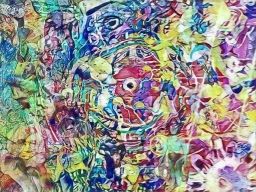
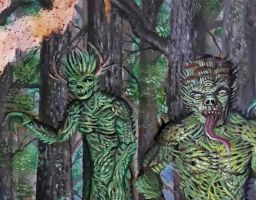
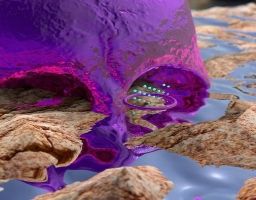

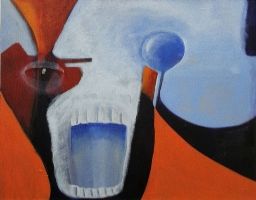
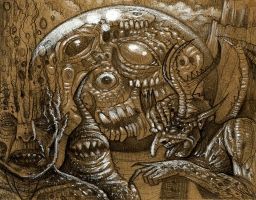



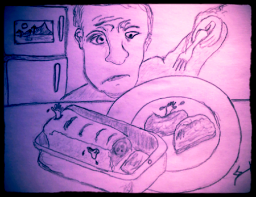
Daniel José Older's
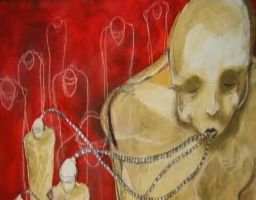
Daniel José Older's
THE COLLECTOR
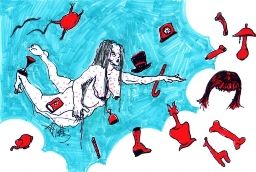
Blag Dahlia's
armed to the teeth
with LIPSTICK
BLAG DAHLIA is a Rock Legend.
A NEW METAPHYSICAL STUDY
REGARDING THE BEHAVIOR
OF PLANT LIFE
Shae is a poet/artist/student and former
PLASTIC CHILDREN
Nigel Strange lives with his wife and

.jpg)



.jpg)
.jpg)

.jpg)




